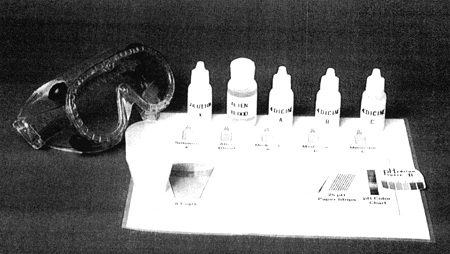Contributed by: The RAND Institute (RAND)
Description:
Students determine which of two solutions is more acidic by adding
each to a given base. Students have to apply the process to a problem
involving an alien creature. In the "Discovery" version, students
design and perform the experiment.
The task assesses students' abilities to design and conduct an
investigation, gather and organize data, come to a conclusion based
on the data, and apply their understanding to an additional situation.
This task is designed to take students approximately 45-60 minutes
to complete.
Overall Task Content Area:
- Physical and Life Sciences
Specific Knowledge Areas:
- Abilities necessary to do scientific inquiry
- Chemical reactions
- The interdependence of organisms
Performance Expectations:
- conducting investigations
- using equipment
- gathering, organizing, and representing data
- formulating conclusions from investigational data
- applying scientific principles to develop explanations and solve
new problems
National Science Education Standards:
8 A SI 1: Abilities necessary to do scientific inquiry:
Grades 5-8
1.2 Design and conduct a scientific investigation. Students
should develop general abilities, such as systematic observation,
making accurate measurements, and identifying and controlling variables.
They should also develop the ability to clarify their ideas that
are influencing and guiding the inquiry, and to understand how those
ideas compare with current scientific knowledge. Students can learn
to formulate questions, design investigations, execute investigations,
interpret data, use evidence to generate explanations, propose alternative
explanations, and critique explanations and procedures.
1.4 Develop descriptions, explanations, predictions, and
models using evidence. Students should base their explanation on
what they observed, and as they develop cognitive skills, they should
be able to differentiate explanation from description — providing
causes for effects and establishing relationships based on evidence
and logical argument. This standards requires a subject knowledge
base so the students can effectively conduct investigations, because
developing explanations establishes connections between the content
of science and the contexts within which students develop new knowledge.
1.8 Use mathematics in all aspects of scientific inquiry.
Mathematics is essential to asking and answering questions about
the natural world. Mathematics can be used to ask questions; to
gather, organize, and present data; and to structure convincing
explanations.
8 B PS 1: Properties and changes of properties
in matter: Grades 5-8
1.1 A substance has characteristic properties, such as density,
a boiling point, and solubility, all of which are independent of
the amount of the sample. A mixture of substances often can be separated
into the original substances using one or more of the characteristic
properties.
1.2 Substances react chemically in characteristic ways with
other substances to form new substances (compounds) with different
characteristic properties. In chemical reactions, the total mass
is conserved. Substances often are placed in categories or groups
if they react in similar ways; metals is an example of such a group.
8 C LS 3: Regulation and behavior: Grades 5-8
3.1 All organisms must be able to obtain and use resources,
grow, reproduce, and maintain stable internal conditions while living
in a constantly changing external environment.
12 B PS 3: Chemical reactions: Grades 9-12
3.1 Chemical reactions occur all around us, for example in
health care, cooking, cosmetics, and automobiles. Complex chemical
reactions involving carbon-based molecules take place constantly
in every cell in our bodies.
(Use the "hot" link on the PALS home page
to check the full text of related National Science Education Standards,
if desired.)
National Council of Teachers of Mathematics:
Algebra (AL1): Understand patterns, relations and functions.
Data Analysis and Probability Standards (DAP1): Formulate
questions that can be addressed with data and collect, organize,
and display relevant data to answer them.
Data Analysis and Probability Standards (DAP3): Develop
and evaluate inferences and predictions that are based on data.
Problem Solving (PS2): Solve problems that arise in mathematics
and in other contexts.
General Instructions to the Teacher:
This task is designed to take students approximately 45-60 minutes
to complete.
Students will be working individually during this exercise.
Students should be ready to work as soon as the period begins.
The materials should be set out at each lab station, if possible.
A central supply area, if needed, should be easily accessible. All
supplies should be clearly labeled.
Materials for Acids and Bases- Alien I (Discovery Version):
The teacher will need:
- Distilled water
- Vinegar (5% solution)
- Ammonia (5% solution)
- Graduated cylinder or other metric measuring device
- Labels and a pen
Each student will need:
- 1 bag pH indicator paper strips
- 1 pH color chart
- 8 plastic measuring cups
- 1 dropper bottle Solution X
- 1 dropper bottle Alien Blood
- 1 dropper bottle Medicine A
- 1 dropper bottle Medicine B
- 1 dropper bottle Medicine C
Advance Preparation
- Prepare 5 dropper bottles for each student.
- Label bottles- "Solution X," "Alien Blood," "Medicine A," "Medicine
B," "Medicine C."
- For Solution X prepare 0.1 ml 5% vinegar and 9.9ml distilled
water
- For Alien Blood prepare 0.03 ml 5% ammonia and 9.97ml distilled
water plus blue dye
- For Medicine A prepare 3 ml 5% ammonia and 7ml distilled water
- For Medicine B prepare distilled water
- For Medicine C prepare 5ml 5% vinegar and 6ml distilled water
Safety:
- Caution the students not to put any of the materials near their
eyes or mouths.
- Caution the students not to smell the solutions.
- Determine a cleanup procedure for spills.
- Be careful.
- Teachers and students should always exercise appropriate safety
precautions and utilize appropriate laboratory safety procedures
and equipment when working on science performance tasks.
Extensions/modifications:
- There are three versions of Acids and Bases Alien. In this
version, the "Discovery" version, students design and perform
the experiment. In the "Recipe" version, students are guided through
the experiment. In the "Text" version, the student reads about
an experiment conducted by another student but does not use any
apparatus.

|


